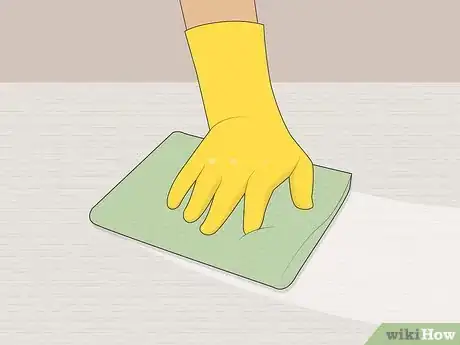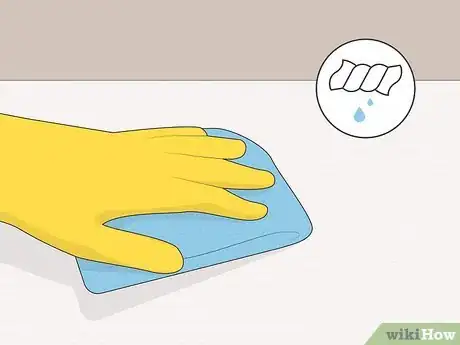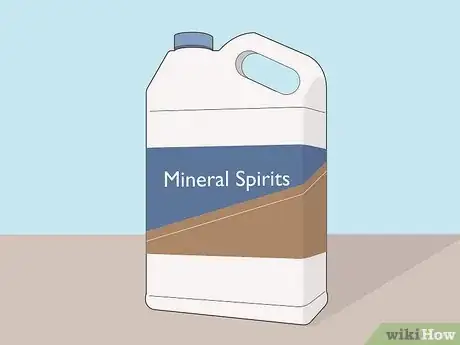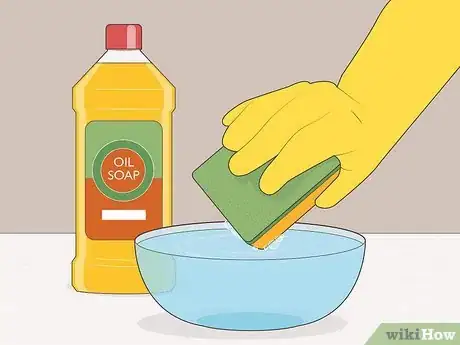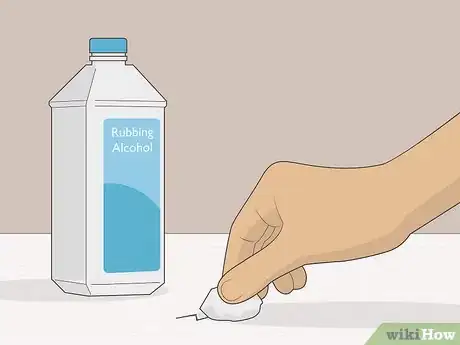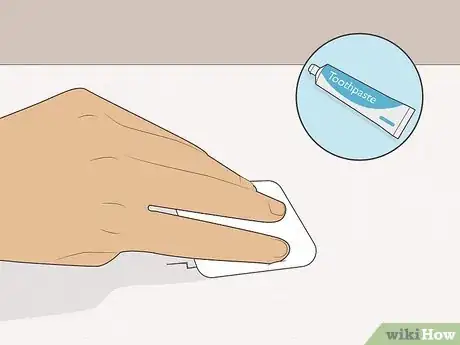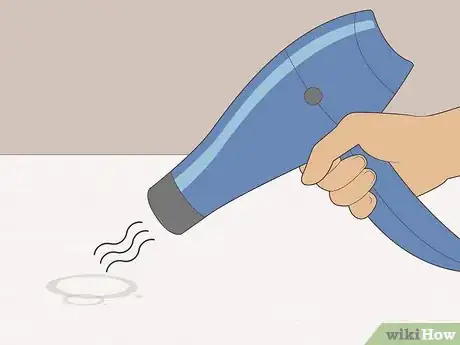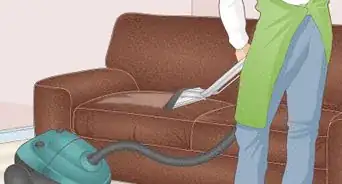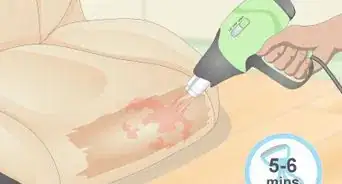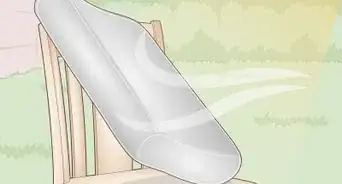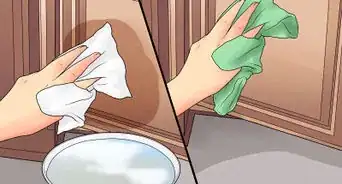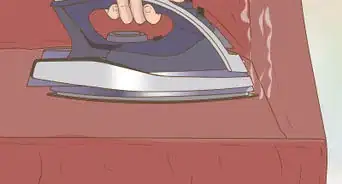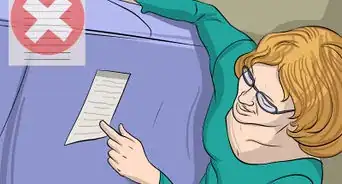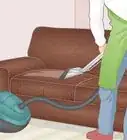This article was co-authored by Cleanzen Cleaning Services and by wikiHow staff writer, Megaera Lorenz, PhD. The Cleanzen Cleaning Services Team consists of Residential Cleaning Specialists. With more than six years of experience, they specialize in connecting independent cleaning professionals with those who need help cleaning their houses. All of Cleanzen’s professionals are experienced and licensed and have passed background checks.
There are 16 references cited in this article, which can be found at the bottom of the page.
This article has been viewed 20,656 times.
White wood furniture is beautiful and fashionable, but it shows dirt and stains easily. It can also get yellowed or discolored over time. If you’re struggling to keep your furniture looking clean and bright, don’t worry. We’ll talk you through the best ways to safely clean your white wood furniture, whether it’s painted, whitewashed, limed, or made from white wood with a natural finish.
Steps
Cleaning Surface Dirt from White Wood Furniture
-
1Dust the furniture with a soft cloth. Dust shows up easily on white wood, making it look dingy and grimy. Fortunately, you can easily tackle this problem by going over your furniture with a soft, lint-free cloth once a week.[1]
- Opt for a dusting cloth instead of a feather duster. Cloths work better for removing dust, and they’re also less likely to scratch up your furniture.[2]
-
2Wipe away dirt with a little soap and water. This is the safest and easiest way to clean most wood, and white wood furniture is no exception. Fill a bucket with warm water, and squirt a little mild dish soap in while the water is running. Dip a corner of a microfiber cloth or soft kitchen sponge into the sudsy water, then wring it out so it’s damp, but not dripping. Gently wipe down the surface of your wood furniture.[3]
- If you’re washing something treated with high-gloss or semi-gloss paint, like a kitchen cabinet, it’s okay to scrub a little. However, be gentle with more delicate finishes, such as whitewash, matte paint, or clear varnish. Wipe the wood lightly instead of scrubbing.[4]
- If you’re not sure how the finish will hold up to soap and water, put a drop of dish soap on a moist cotton ball. Gently rub the cotton ball on the furniture in an inconspicuous spot to make sure there’s no damage.
Advertisement -
3Remove soap residue with a damp cloth. The last thing you want is to leave icky soap streaks on your furniture. To get all the soap off, dip your cleaning cloth or sponge in a bucket of fresh, clean water. Squeeze out most of the moisture, then gently buff residue away using circular motions.[5]
- You might need to wipe down the item a couple of times to get all the soap off.
-
4Dry your furniture thoroughly with a soft towel. Lots of moisture is bad news for wood, especially if it has a delicate finish that water can easily seep through.[6] To keep your white furniture in good shape, always dry it carefully after you’re done cleaning it. Wipe it down with a soft, clean, lint-free towel.
- Avoid using lots of water when you’re cleaning any type of wood furniture. Always use a cleaning cloth or sponge that’s only lightly damp, not sopping wet.
-
5Brighten clear finishes with mineral spirits. Mineral spirits, also known as white spirit or mineral turpentine, are great for cleaning wood furniture and restoring its shine. If you have unpainted wood furniture with a clear finish (such as lacquer, shellac, varnish, or polyurethane), wipe it down with a soft cloth dipped in mineral spirits. Use gentle, circular motions. When you’re done, buff the furniture a second time with a clean, dry cloth to remove all the mineral spirits.[7]
- Mineral spirits can damage some finishes, such as paint. If you’re not sure whether mineral spirits will harm your furniture, test it in an inconspicuous spot first.[8]
- This is a good option for unpainted furniture made from naturally white wood, such as holly, or bleached or whitewashed wood coated with a clear finish.
Removing Stains from White Wood Furniture
-
1Clean up grease stains with soap and water. You can tackle most oil and grease stains on white wood furniture just like you would any other type of dirt—with a bit of dish soap. Soaps specially formulated for wood, such as Murphy Oil Soap or Fuller’s Oil Soap, will also do the trick.[9] Gently wipe the spot with a cloth or sponge dipped in soapy water, then wipe away any soap residue with a second cloth dampened in clean water.
- Don’t forget to wipe the area dry when you’re done.
-
2Banish marker stains with rubbing alcohol. If your toddler has been scribbling on your favorite white dresser, don’t panic. A little alcohol will usually clean it right up. Moisten a cotton ball or makeup pad with a rubbing alcohol and gently dab it on the stain to lift out the ink.[10]
- Try not to scrub, since you could spread the stain around or damage the finish on the wood. Always test the alcohol in a hidden spot if you’re not sure how it will affect your furniture.
-
3Get ink stains out with toothpaste. You can also try gently buffing out ink or marker stains with baking soda-based, non-gel toothpaste on a soft cotton pad. Wipe in the direction of the wood grain, then wipe the area with a damp cloth when you’re done.[11]
- You can buy baking soda-based toothpastes at most drugstores. However, if you can’t find it, just mix a little baking soda into a white, non-gel toothpaste to create your own.
- Some people also claim that toothpaste can brighten yellow spots on white furniture.
-
4Kill surface mold with distilled white vinegar. If your white furniture has a little mildew on it, you might be able to clean it away with soap and water. However, for more serious infestations, white vinegar can help. Mix equal parts vinegar and warm water in a spray bottle and spritz it on the area with the mold. Let it sit for an hour before wiping it away with a rag dampened in clean water. Dry the area thoroughly when you’re done.[12]
- For really stubborn mold, try scrubbing the area with a solution of 1 tablespoon (26 g) of Borax and 1 cup (240 mL) of water and a soft-bristle brush. Don’t wipe or rinse the solution away—just let it air dry, or use a dehumidifier to speed the drying process.
- Unfortunately, even diluted vinegar can dull or damage some paints or wood finishes. It might be necessary to repaint or refinish the affected area after treating the mold.
- For severe mold infestations, you may need to sand down the wood or even replace the damaged sections of your furniture.
-
5Remove water rings on unpainted white wood with a hair dryer. Water can leave ugly stains on unpainted wood, especially if your furniture has a clear finish. Fortunately, it’s usually pretty easy to get those stains out. Aim a hairdryer set on low at the stained area, gently moving the stream of air around to avoid overheating the wood. The stain should fade after a few minutes. If that doesn’t work, try one of these options:[13]
- Gently buff the stain with a dab of mayonnaise or petroleum jelly. If the stain is stubborn, let the mayo or petroleum jelly sit on the spot for a few hours or even overnight before wiping it away.
- Use a soft cloth to rub a little white, non-gel toothpaste into the stain, moving with the grain of the wood. Wipe the paste away with a damp cloth when you’re done, then dry the area.
- For set-in water stains, put a few drops of lemon oil on the area. Then, carefully rub the stain with very fine grade steel wool, moving in the direction of the wood grain.
- You can also buy commercial water stain removers. Always test these products in an inconspicuous area first.
Restoring Yellowed White Wood Furniture
-
1Brighten oil-based paints with sunlight. While you might have heard that too much light can cause white furniture to yellow, in many cases just the opposite is true. If your white furniture is finished with an oil-based paint, putting it in a well-lit or sunny area may help reverse any yellowing and restore it to its former glory.[14]
- If you can’t put your furniture in a sunny spot, artificial light will work as well. Place a lamp near the item and leave it on during the day to keep the area well lit.
- On the other hand, sunlight can cause some types of wood or wood finishes to darken or become yellow. If you’re not sure how light will affect your furniture, consult a wood repair or restoration expert for advice.
-
2Clean off yellow stains with trisodium phosphate. Trisodium phosphate, or TSP, is an alkaline cleaner that can remove many types of stubborn stains and dirt. If your painted white furniture has yellowed due to exposure to grease, cigarette smoke, or cooking fumes, try cleaning it with TSP. Dissolve ¼ of a cup (150 g) of TSP in 1 gallon (3.8 L) of water, then dip a sponge or cloth into the solution and wring out the excess moisture. Gently wipe the stained area with the solution, then wipe it dry with a clean cloth.[15]
- TSP can irritate your eyes and skin. Always wear gloves, long sleeves and pants, and safety goggles while cleaning with TSP. You may also wish to wear a respirator mask while working with dry TSP to avoid inhaling any of the powder.[16]
-
3Fix dings and scratches with a white wood touchup marker. No matter how careful you are, the finish on your white wood furniture can sometimes get scratched or chipped. If this happens, don’t worry. You can easily touch up those little flaws with a wood repair marker. These markers come in a wide range of colors, including white and off-white. Simply color over the scratch with the marker to hide it.
- You can purchase wood repair markers online or from a hardware or home supply store.
-
4Brighten stained or darkened pieces with wood bleach. Wood bleach can both lift stains and brighten the natural color of the wood.[17] Before using bleach, you’ll need to strip off any finishes or coatings on the wood.[18] Apply a commercial wood bleach, such as two-part bleach or oxalic acid, according to the directions on the package. Follow the safety instructions carefully to avoid hurting yourself or damaging the wood.
- If the wood is already raw, clean it thoroughly with a rag dipped in water or mineral spirits before applying the bleach.[19]
- Always work in a well-ventilated space and wear protective equipment, such as safety goggles and gloves, when using any type of wood bleach.
- You may need to neutralize some types of bleach after applying them with a second solution, such as a 50:50 mix of white vinegar and water.[20]
- Rinse the bleached wood thoroughly with warm water when you’re done, and allow it to air dry completely before adding any new paints or finishes.[21] [22]
-
5Repaint or refinish badly stained wood. If the paint or finish on your furniture is badly stained or yellowed, you can always touch it up or repaint it altogether. If the item is already painted, simply clean it, then add a coat of primer and paint over the old paint with a fresh coat. Choose a water-based white paint to avoid problems with yellowing.[23]
- Use a varnish or paint remover to strip off old paints or finishes before applying a new type of finish, such as whitewash, varnish, or liming wax. Follow the instructions on the package to make sure you are using the product correctly.
- In some cases, you may be able to simply chip away cracked, stained, or peeling paint with a paint scraper. Sand the area down, then touch it up with a fresh coat of paint that matches the original finish.
References
- ↑ https://www.latimes.com/archives/la-xpm-1995-09-30-hm-51540-story.html
- ↑ https://www.bobvila.com/articles/how-to-clean-wood-furniture/
- ↑ https://www.thekitchn.com/how-to-clean-painted-wood-cabinets-248277
- ↑ https://www.bobvila.com/articles/how-to-clean-wood-furniture/
- ↑ https://www.thekitchn.com/how-to-clean-painted-wood-cabinets-248277
- ↑ https://antiques.lovetoknow.com/about-antiques/how-clean-antique-wood-furniture-like-pro
- ↑ https://www.bobvila.com/articles/mineral-spirits-uses/
- ↑ https://cleaning.lovetoknow.com/house-cleaning-tips/cleaning-mineral-spirits-clever-household-uses
- ↑ https://www.thisoldhouse.com/furniture/21017996/how-to-fix-a-furniture-finish
- ↑ https://www.today.com/home/here-are-3-tried-true-ways-remove-permanent-marker-wood-t99596
- ↑ https://www.today.com/home/here-are-3-tried-true-ways-remove-permanent-marker-wood-t99596
- ↑ https://www.thisoldhouse.com/green-home/21331232/killing-mold-on-wood
- ↑ https://www.architecturaldigest.com/story/ways-to-remove-water-stains-from-wood
- ↑ https://www.bobvila.com/articles/yellowing-paintwork/
- ↑ https://www.bobvila.com/articles/yellowing-paintwork/
- ↑ https://www.thisoldhouse.com/cleaning/22221192/trisodium-phosphate
- ↑ Cleanzen Cleaning Services. Residential Cleaning Specialists. Expert Interview. 4 February 2022.
- ↑ https://www.nytimes.com/1986/03/30/nyregion/home-clinic-bleaching-wood-two-ways-to-get-down-to-the-nitty-gritty.html
- ↑ https://www.bobvila.com/articles/bleaching-wood/
- ↑ Cleanzen Cleaning Services. Residential Cleaning Specialists. Expert Interview. 4 February 2022.
- ↑ https://www.fpl.fs.fed.us/documnts/fplrn/fplrn165.pdf
- ↑ Cleanzen Cleaning Services. Residential Cleaning Specialists. Expert Interview. 4 February 2022.
- ↑ https://www.bobvila.com/articles/yellowing-paintwork/
